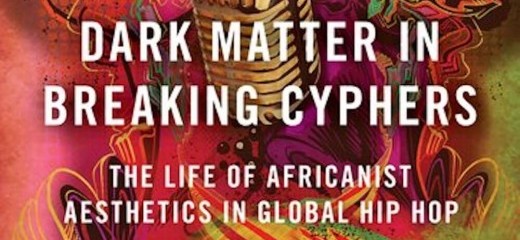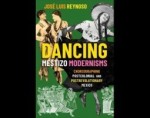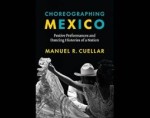
Breaking Through to the Unseen
by Amy Schofield
In her recent book, Dark Matter in Breaking Cyphers: The Life of Africanist Aesthetics in Global Hip Hop, Imani Kai Johnson uses the physics concept of “dark matter” as a metaphor to illuminate the “invisibilized Africanist aesthetics” within breakdancing cyphers (p. xiv). In physics, dark matter is believed to make up the majority of our universe. Though it cannot be seen because it does not reflect visible light, dark matter’s presence is understood by its gravitational effects. For Johnson, dark matter speaks to the possibilities of the unseen, which challenges hierarchies of knowledge and understanding. Based on Johnson’s 2009 doctoral dissertation, the book highlights the alternative epistemologies that are taught and transmitted through Hip Hop dance cyphers, communal dance circles in which participants enter one by one to dance in the center.
Johnson argues that looking beyond spectacular power moves to the often unseen or invisibilized elements of breaking cyphers activate new possibilities of knowledge and ways of being. To support this, she draws from ethnographic fieldnotes from breaking events, oral history interviews, informal conversations with artists, movement analysis, and archival research. She also incorporates her own storytelling and anecdotes throughout the book. These vignettes illustrate the presence of various forms of knowledge beyond notions of theory and formal analysis. In one particularly exciting passage about what it’s like to participate in a cypher, she describes:
“More than a mere chain reaction, the circle’s initial casualness births something at once shared and transmitted, first by [B-boy] Smurf and then by the whole of the circle. Or maybe it’s something channeled, making Smurf a kind of shaman who’s brought forth a force at this moment, compelling a new focus from those of us surrounding him. The goings-on of the rest of the club fall away, and the intimacy of our little cypher becomes its own world.” (p. 27)
The book’s five chapters are arranged conceptually, each touching on a different aspect of breaking cyphers. Johnson begins by contextualizing the circular formation of cyphers with a look at other African diasporic circle practices such as ring shout, capoeira, and Puerto Rican bomba. Ideas of call and response, energy exchange, ritual connection to ancestors, collective release, community healing, and feelings of liberation are present in each of the forms she analyzes. She then focuses on how life in the South Bronx in the 1970s influenced Hip Hop sound and aesthetics. Using the term “outlaw culture,” which Johnson associates with precarity and marginality rather than criminality, she argues that Hip Hop battling reflects embodied knowledge, social understandings, and self- and community-preservation techniques. Her analysis of B-girls and aesthetics of “badass femininity” asserts that female breakers defy the gender binary and expectations of femininity through their use of satire, risk-taking, and expressions of strength through their movement. Johnson’s argument—that the Africanist aesthetics of Hip Hop are at risk of being invisibilized—is fully realized towards the end of her book. She discusses global Hip Hop and how breakers negotiate issues of race, ethnicity, gender, and nationality. She raises questions on how Hip Hop can continue to foreground Africanist aesthetics and philosophies as it circulates the globe and takes on new cultural contexts. Finally, in a coda, Johnson contemplates Hip Hop online and how algorithms can either amplify or further invisiblize Africanist aesthetics.
In the upcoming 2024 Paris Olympics, breaking will be included as an official sport for the first time, making Johnson’s questions surrounding structures of power and the transmission of cultural and embodied knowledge even more timely and important. Her research leads me to ask: Where might aesthetics of “outlaw culture” and “badass femininity” fit into ideas of objectivity and the scoring of Hip Hop and street dance? What are the stakes of scoring vocabulary and technical prowess, and who will be the judges? Johnson remarks:
“During my fieldwork, I have both witnessed and heard countless complaints about how young dancers from around the world correlate moving freely in Hip Hop street dances to being free to do anything and still call it their version of Hip Hop, a misunderstanding of the imperative to innovate and no appreciation for the aesthetic imperatives, techniques, and histories that mattered.” (emphasis in original, p. 155)
In other words, while competition and battling lead to growth and innovation, when taken out of its historical and cultural context, Hip Hop performers run the risk of rehearsing anti-blackness and perpetuating the invisibilization of the form’s Africanist aesthetics.
The 2024 Olympics is outside of the scope of Johnson’s project, especially considering she conducted her fieldwork mostly in the United States between 2005 and 2012. Johnson generously names her interlocutors, giving credit and credence to the breaking practitioners she interviewed. This does important work of honoring embodied knowledge, personal experience, and varied ways of being and knowing. While the metaphor of dark matter is intriguing, it was underutilized as a throughline within the text. As I read, I found myself craving a deeper connection between Johnson’s findings regarding breaking, cyphers, and Africanist aesthetics, and the presence and behavior of dark matter. Overall, the book is clearly written and accessible, and is pertinent to those interested in Hip Hop and street dance, Africanist aesthetics, and ways knowledge is transmitted from body to body.
Imani Kai Johnson, Dark Matter in Breaking Cyphers: The Life of Africanist Aesthetics in Global Hip Hop. New York: Oxford University Press, 2023.
By Amy Schofield
October 27, 2023










